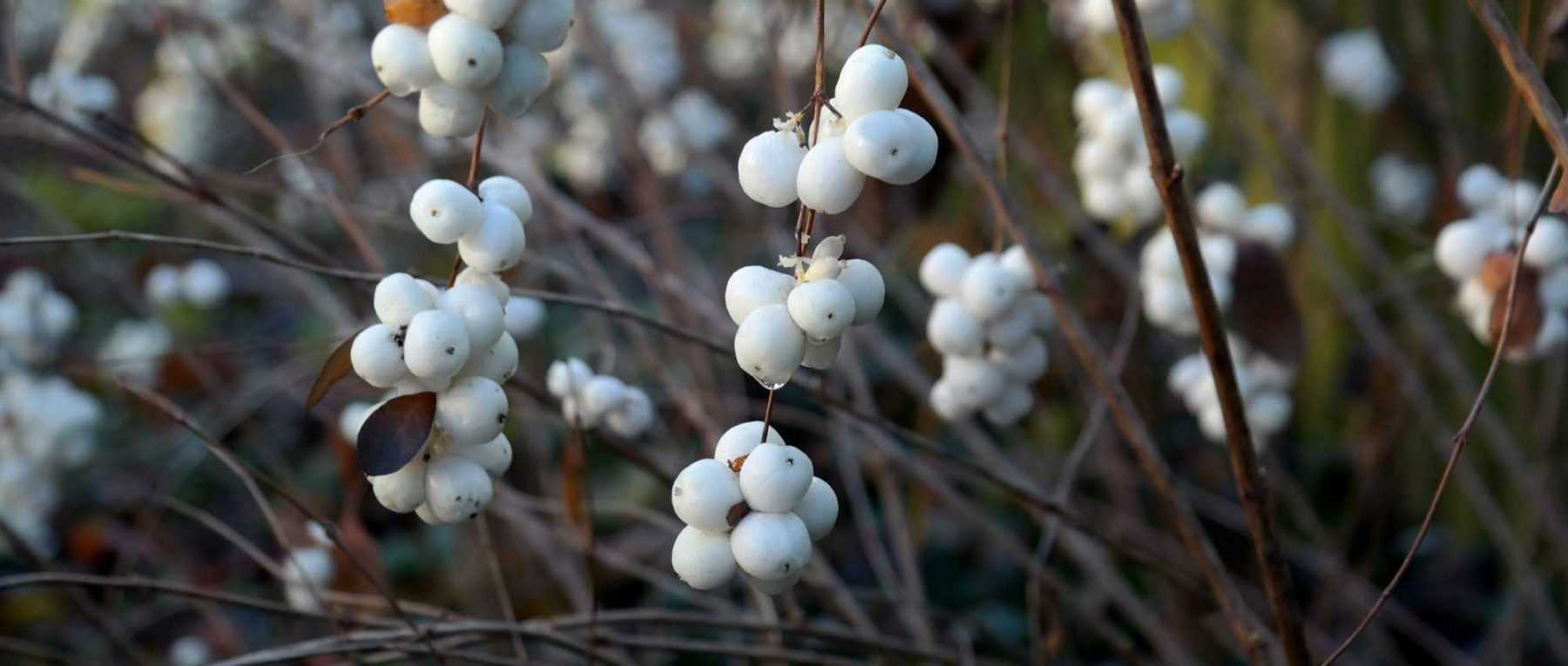
Snowberry: Planting, Pruning and Care
Contents
The snowberry in a nutshell
- The snowberry produces decorative berries in very soft shades of white or delicate pink
- It’s perfect for incorporating into a hedge or creating a backdrop for flower beds.
- Easy to grow, it’s rarely affected by diseases – a hardy and completely frost-resistant plant
- It tolerates shady, even dry conditions well
- Its nectar-rich flowers and berries promote biodiversity by attracting insects and birds!
Our Expert's Word
The snowberry, or Symphoricarpos, is a deciduous shrub whose decorative rounded berries earn it the charming nickname “pearl bush”. The berries range in colour from white to pink, often with beautiful silvery highlights. The most common species is the white snowberry, Symphoricarpos albus, but there are also remarkable horticultural varieties such as ‘Magic Berry’, with purple-pink berries. There’s even a creeping snowberry, suitable as ground cover: Symphoricarpos x chenaultii ‘Hancock’. With its nectar-rich flowers and abundant fruiting, the snowberry is an ideal plant for promoting biodiversity by attracting insects and birds to the garden!
Easy to grow, the snowberry is a low-maintenance shrub that tolerates cold, drought, pollution and diseases rather well! Planting takes place in spring or autumn, in fresh, well-drained soil. The snowberry thickens over time, making it perfect for hedges or creating a green screen at the back of a garden. It brings a very natural and wild touch! It requires little maintenance but will appreciate an annual compost feed and pruning in late winter.
Botany
Botanical data
- Latin name Symphoricarpos sp.
- Family Caprifoliaceae
- Common name Snowberry
- Flowering summer
- Height up to three metres
- Exposure sun or partial shade
- Soil type rich, moist, well-drained
- Hardiness -20 to -25 °C
Snowberries are deciduous shrubs that produce decorative berries in autumn. They are native to North and Central America, with the exception of Symphoricarpos sinensis, which originates from western China. Most species are found in the United States and Mexico. This is a small group of plants, comprising only 16 species, which have given rise to some superb horticultural varieties. The best-known species is Symphoricarpos albus, native to the United States and introduced to Europe in the early 19th century, where it tends to naturalise. In the wild, snowberry is mainly found in woodland undergrowth or hedgerows, sometimes in meadows and along riverbanks.
Snowberry belongs to the Caprifoliaceae family. This is the family of honeysuckle, red valerian (Centranthus ruber), teasel (Dipsacus), knautia and scabious, valerian, and some ornamental shrubs such as abelia, kolkwitzia and weigelia…
Etymologically, the Latin name Symphoricarpos comes from the Greek sumphoréō: to gather, and karpós: fruit, as the berries are usually clustered, rarely solitary. The species name albus means white, referring to the colour of the berries. The scientific name Symphoricarpos then gave rise to the common name Snowberry. In English, it is called Snowberry.
Snowberry is an upright, fast-growing shrub. It has spreading rhizomes from which suckers emerge, allowing it to spread widely, making hedges denser and bushier. If planted near other plants, it can invade their space and will need to be controlled (pruning, removing suckers…).
It has slender, arching, flexible branches. It has a rather light appearance, but quickly fills out to form a dense, bushy shrub within a few years. In Symphoricarpos chenaultii, the stems have a lovely pinkish hue, providing a slight contrast with the green foliage.
Generally, snowberry grows to a maximum height of two metres, but can sometimes reach three metres depending on the variety. Some shrubs have a very spreading habit and can be used as ground cover. This is the case with Symphoricarpos x chenaultii ‘Hancock’.
In summer, between July and September, snowberry produces very discreet flowers, not particularly interesting from an ornamental point of view. It then bears small white-pink flowers, shaped like little bells. They are often clustered in racemes, sometimes in pairs, more rarely solitary. They consist of five petals fused into a bell shape and five stamens. The inside of the corolla is surprisingly hairy. The flowers are usually less than seven millimetres long. They are nectar-rich and appreciated by bees.
Once flowering is over, in autumn the snowberry bears spherical or ovoid berries, white or pink, sometimes red. They often have beautiful silvery reflections. They are red-purple in Symphoricarpos orbiculatus. Depending on the variety, they may be more or less mauve. Symphoricarpos leucocarpa has pure white, immaculate fruits. The berries are clustered together on the stems. They are often less than one centimetre in diameter, but can sometimes reach up to 6 cm in diameter, as in Symphoricarpos x chenaultii. They remain in place for a long time and can persist in winter after the leaves have fallen. They are eaten by birds, but unfortunately are not edible for humans.
Each berry contains two white seeds. You can collect them to sow, but they are tricky to germinate as their coat is hard and impermeable. They can remain dormant for 10 years and require stratification to break this dormancy.


Snowberries can be pink or white. Left, Symphoricarpos ‘Mother of Pearl’; right, Symphoricarpos albus (photo H. Zell)
Snowberry leaves are simple, entire, and oval or elliptical in shape. Those of Symphoricarpos albus are sometimes irregularly lobed. They measure between two and five centimetres in length and are attached to the branch by a very short petiole. They have a very ordinary appearance, but also a soft and delicate side. They are dark green, bluish, and their underside is a slightly lighter shade. The doorenbosii species, which has given rise to many varieties such as ‘Mother of Pearl’, has darker foliage, tending towards blue. There are even variegated snowberries, with leaves edged in creamy white or yellow, such as Symphoricarpos albus ‘Variegatus’ or Symphoricarpos orbiculatus ‘Follis variegatis’. The leaves are opposite, arranged in pairs, one opposite the other, on the stems. Snowberry leaves are deciduous: they disappear in autumn and reappear in spring.
The main varieties of snowberries

Symphoricarpos doorenbosii Amethyst
- Flowering time July to November
- Height at maturity 1,50 m

Symphorycarpos doorenboosii Mother Of Pearl
- Flowering time July to September
- Height at maturity 1,50 m

Symphoricarpos doorenboosii White Hedge
- Flowering time July to October
- Height at maturity 1,50 m
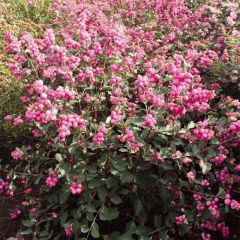
Symphoricarpos doorenboosii Magical Candy
- Flowering time July to November
- Height at maturity 1,50 m
Discover other Symphoricarpos
Planting Snowberry
Where to plant?
The snowberry is an undemanding plant, capable of adapting to various conditions.
Plant it preferably in full sun or partial shade. Although it can tolerate shady spots, good light exposure is necessary to ensure proper flowering and thus abundant fruiting. If you live in northern France, opt for a sunnier position, while in the south, partial shade will work perfectly.
Snowberries thrive in fertile, organic-rich soil. Add compost or well-rotted manure at planting time and then every autumn.
Plant in well-draining yet moisture-retentive soil. It dislikes heavy, clay soils that remain waterlogged in winter. If your soil is like this, add a drainage layer (pumice, gravel, etc.) when planting.
Snowberries are ideal for urban gardens as they tolerate pollution well. They seem to prefer neutral or slightly alkaline soils. Avoid planting in distinctly acidic soil. It’s also a very hardy plant, so no protection is needed against frost or wind.
Snowberries are particularly suited to planting at the back of a garden or in hard-to-reach areas where maintenance is minimal. They’ll form a dense, low-maintenance screen that thickens over the years. To cover a slope, choose the Symphoricarpos x chenaultii ‘Hancock’ variety, which has a spreading habit, making it an excellent ground cover.
When to plant?
Although planting can be done year-round, we recommend planting snowberries preferably in spring or autumn. Avoid frosty periods.
How to plant?
- Soak the root ball by placing it in a bucket of water.
- Dig a planting hole, two to three times the size of the root ball.
- Add well-rotted compost. If your soil is clay-heavy, mix in pumice or gravel to improve drainage.
- Place the plant in the hole.
- Backfill with soil and firm gently.
- Water thoroughly.
- Apply a mulch layer around the base.
You can also grow it in a container, provided it has sufficient depth.
Discover everything you need to know about snowberries in our video:
Maintenance
The snowberry will appreciate an annual application of compost or manure, which should be spread at the base of the shrub in autumn.
We recommend mulching with dead leaves or chipped branch wood (BRF). This will help retain soil moisture, prevent weeds from growing, and enrich the soil with organic matter.
Prune at the end of winter, around March. If you prune in summer or early autumn, you risk losing the berries. Pruning helps the snowberry maintain a more compact and dense shape. Start by removing damaged or dead branches. If the plant appears weak, carry out rejuvenation pruning by cutting back quite hard. Otherwise, simply perform light maintenance pruning, controlling its height (especially if grown as a hedge) and trimming branches that grow in the wrong direction or tangle with other plants. You can also thin out the centre to improve air circulation within the shrub.
The snowberry produces numerous suckers that gradually spread and may encroach on nearby plants. If your garden is small and plants are closely spaced, you’ll need to remove these suckers to limit its expansion.
Easy to grow and largely trouble-free, the snowberry is highly resistant to diseases and pests.
Propagation
To propagate snowberry, we recommend taking cuttings or removing suckers. It can also be propagated by layering.
Taking Cuttings
Take semi-hardwood cuttings in late summer or early autumn, ideally around September.
- Prepare a pot by filling it with a mix of compost and sand, then water to moisten the substrate.
- Take a cutting about 10 cm long from a healthy branch, free from disease or damage. Make a clean cut just below a node (where leaves attach to the stem). Remove any leaves from the lower third of the cutting, keeping only a few leaves at the top. Also, remove any flowers or fruit.
- Optionally, dip the base of the cutting in rooting hormone. This step is not essential.
- Make a hole in the substrate and insert the cutting.
- Firm the soil around the stem.
- Place the pot out of direct sunlight.
Keep the substrate moist until the cutting takes root, which should take one to two months. Grow it in a pot for a year before planting it in the ground the following autumn.
Removing Suckers
Snowberry is a suckering plant, producing new shoots from underground rhizomes. You can remove these suckers in autumn by separating them from the parent plant. Plant them in deep pots. Keep them sheltered from direct sunlight and ensure the substrate stays moist. Once established, they can be planted in their permanent location.
Sowing Seeds
Snowberry seeds are difficult to germinate. They have a protective dormancy, and their hard, thick seed coat makes them resistant. They can remain viable for up to ten years. Germination is slow, and seeds require stratification to break dormancy.
- Extract the seeds from the berries.
- Fill a tray with sand and compost, moisten the substrate, and mix in the seeds.
- Warm stratify by placing the pot at around 25°C for three to four months.
- Then cold stratify at 5°C for six months.
- Sow the seeds in pots filled with compost, covering them with a very thin layer of substrate.
- Shelter the pots over winter. Wait one to two years before transplanting them to their final location.
Association
With its ability to sucker, spread and develop a bushy habit over time, the snowberry is perfect for creating a dense hedge, particularly at the back of a garden or in hard-to-reach spots. Pair it with other shrubs to create a country-style hedge: viburnum, hawthorn, hornbeam, hazel… Remember to include some evergreen foliage plants, such as pieris, cotoneaster, camellias, mahonia, pittosporum…
Plant snowberry alongside other ornamental berry shrubs: enjoy the splendid purple berries of beautyberry, the red fruits of cotoneaster, sacred bamboo or rowan… Also discover the unique red and orange berries of spindle (Euonymus europaeus)! And those of Viburnum opulus, particularly the ‘Xanthocarpum’ variety with its yellow-orange berries!
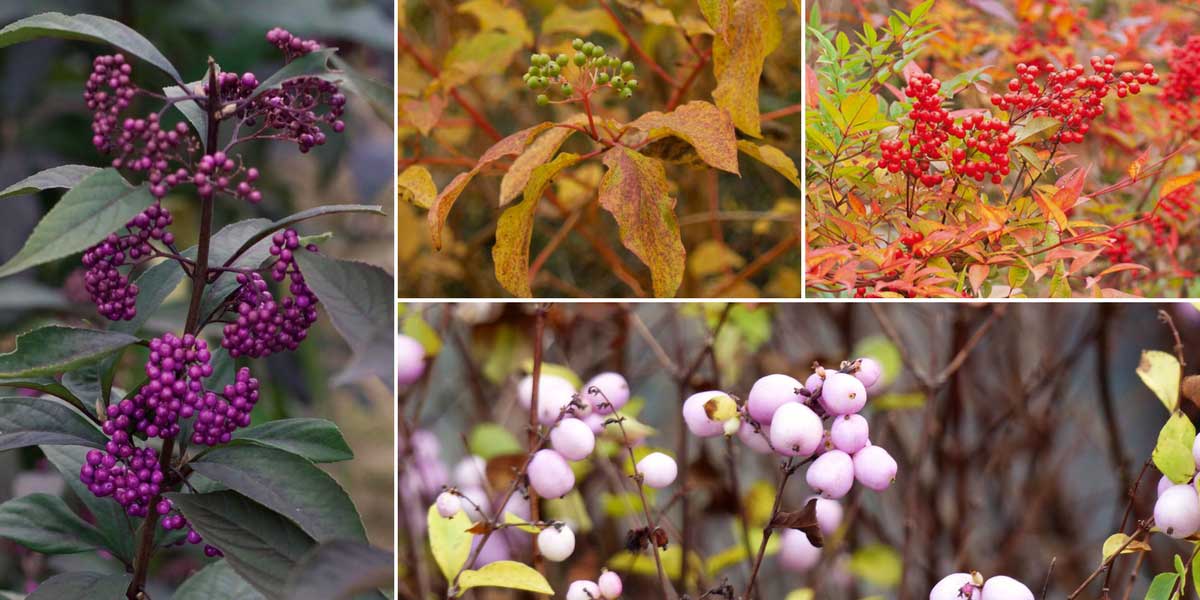

Pair snowberry with other decorative berry and foliage shrubs! Callicarpa ‘Purple Pearls’, Cornus sanguinea ‘Winter Beauty’, Nandina domestica and Symphoricarpos ‘Mother of Pearl’
Combine snowberry with autumn-flowering shrubs, such as Camellia sasanqua, Osmanthus (Osmanthus fragrans or heterophyllus), laurustinus (Viburnum tinus) or Mahonia ‘Soft Caress’. Use snowberry as a backdrop for your flowerbed, planting colourful flowering plants in front: asters, chrysanthemums, heathers… Also enjoy the decorative plumes of fountain grass! You can choose long-flowering plants that will draw attention in summer but remain decorative in autumn to complement the snowberry’s berries. Opt for Gaura lindheimeri or Argentine vervain.
You can create a splendid autumn scene by pairing snowberry with plants whose foliage takes on fiery hues in autumn: Japanese maple, dogwood, viburnum, or the stunning Parrotia persica… Also enjoy trees and shrubs with decorative bark, such as common dogwood, Prunus serrula or Acer palmatum ‘Sangokaku’.
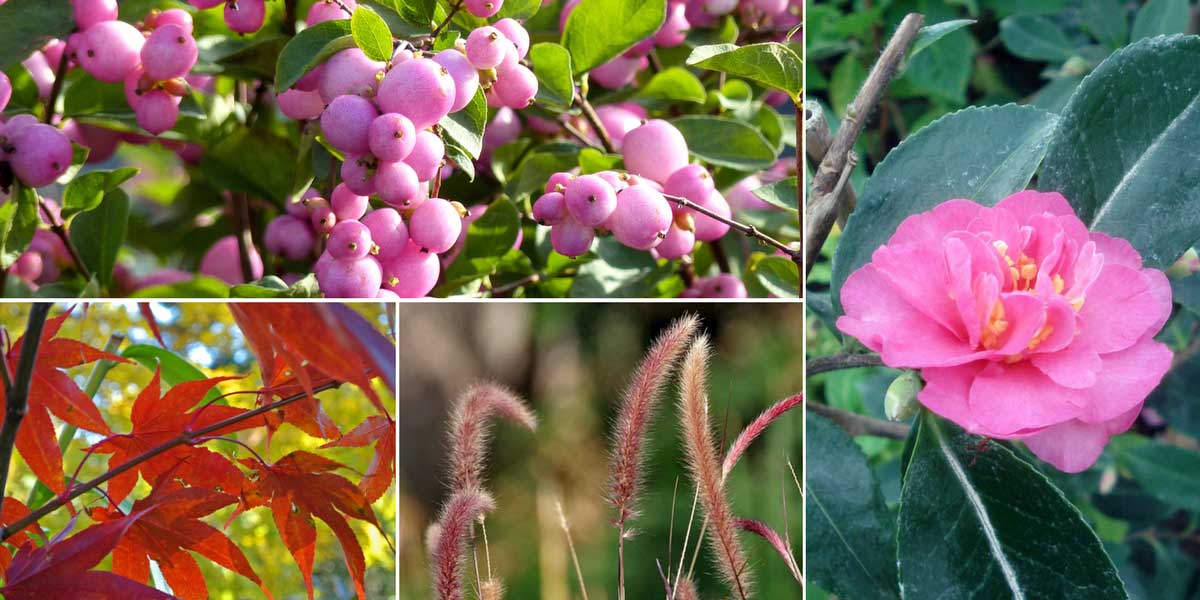

Symphoricarpos ‘Mother of Pearl’, Acer palmatum ‘Osakazuki’ (photo James Steakley), Pennisetum setaceum and Camellia sasanqua ‘Showa no Sakae’
Snowberry tolerates pollution well and is therefore suited to urban gardens. You can pair it with decorative evergreen foliage: ferns, ornamental grasses, heucheras, and structural plants: bamboos, Japanese maples, hostas, horsetails, mahonias…
As snowberry naturally tends to spread, you can also plant it as a standalone specimen. This will prevent it from mingling with other shrubs and invading their space.
Did you know?
- Properties and uses
The bark, roots and flowers of the snowberry have medicinal properties, particularly as a febrifuge and diuretic. It was used by Native Americans and is still employed today in homeopathy. However, its berries are considered toxic and likely to cause nausea and irritation.
Useful resources
- Discover our range of snowberries!
- An article by Pierre on our blog – Snowberries and their candy-like fruits!
- Snowberry: which variety to choose for dressing a slope?
- Discover our video about snowberries
- Learn more about plants with toxic berries
Frequently asked questions
-
My snowberry isn't producing (or produces very few) berries!
Be mindful of the pruning period: the snowberry should be pruned in late winter... if you've done it in summer, or after flowering, it couldn't form berries. Similarly, although the snowberry tolerates shade, good light exposure is important to ensure generous fruiting. In dense shade, it will produce fewer berries.
- Subscribe!
- Contents


































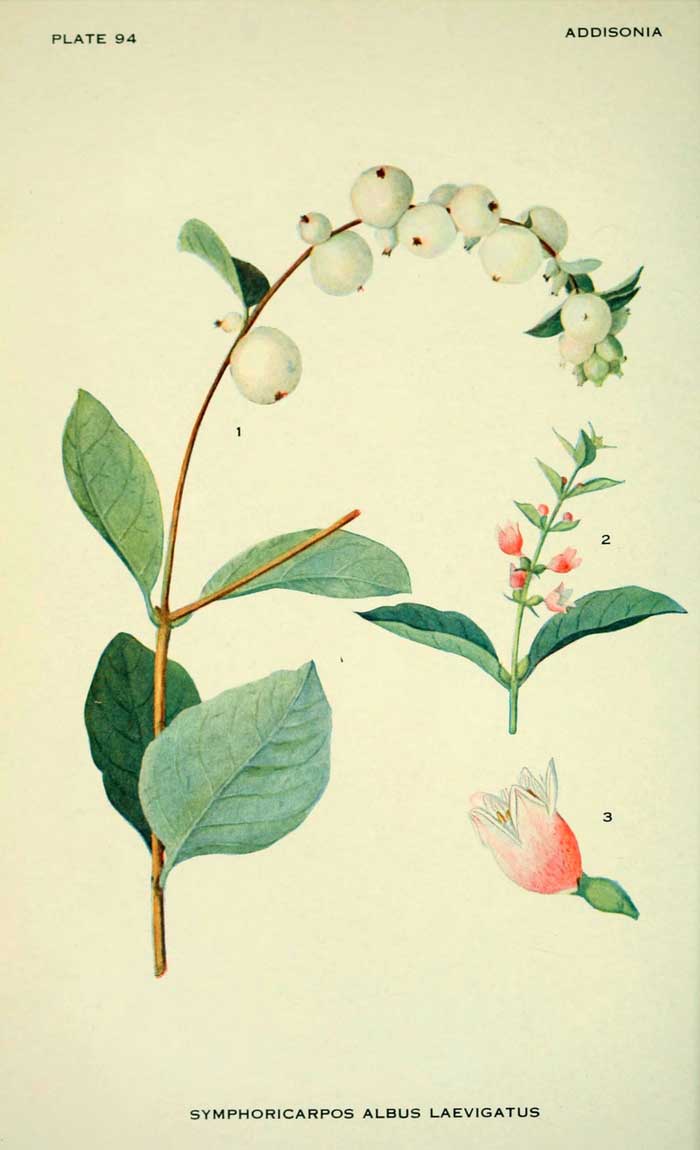

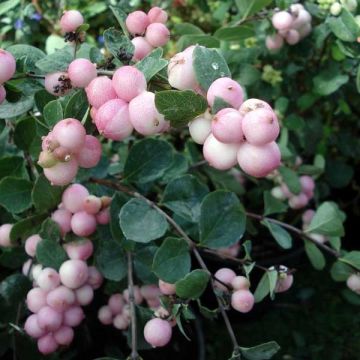
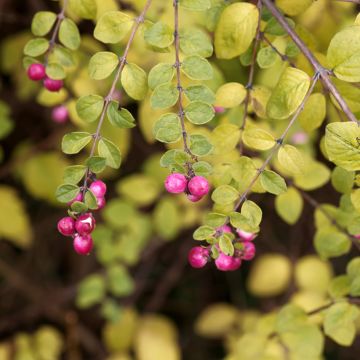
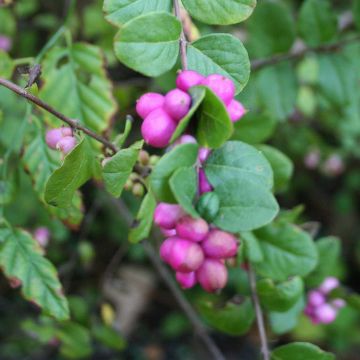

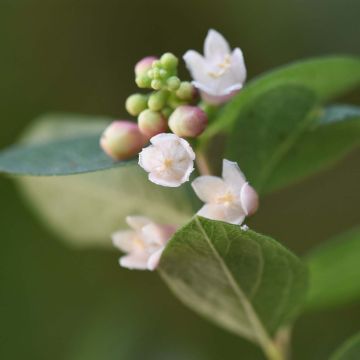

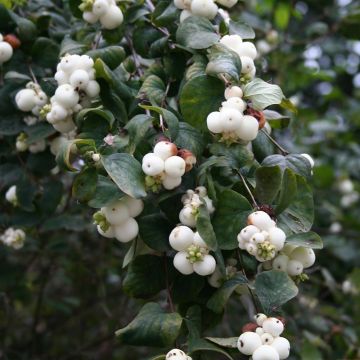
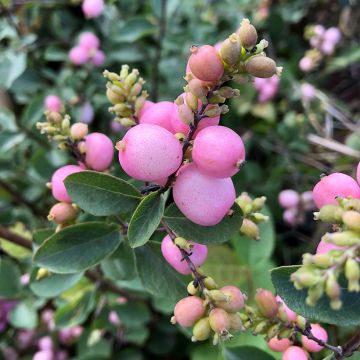

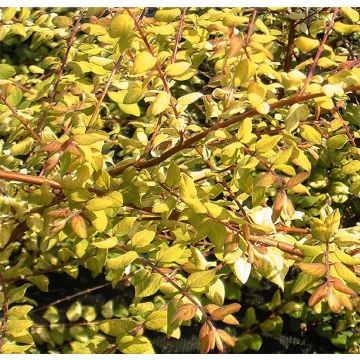
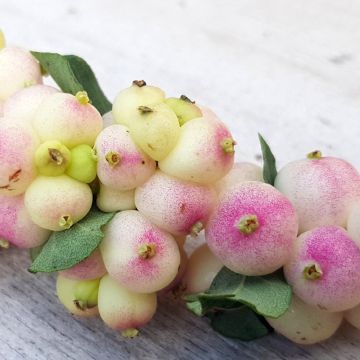
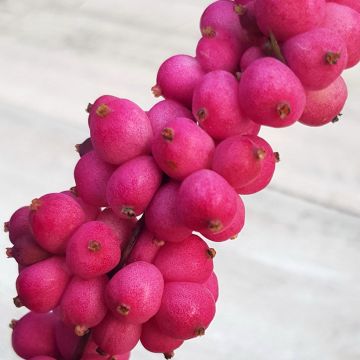
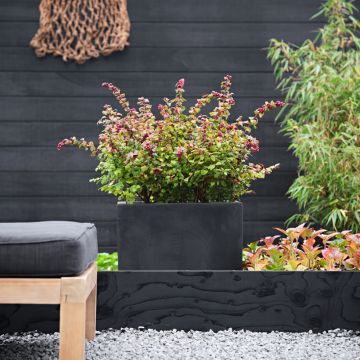
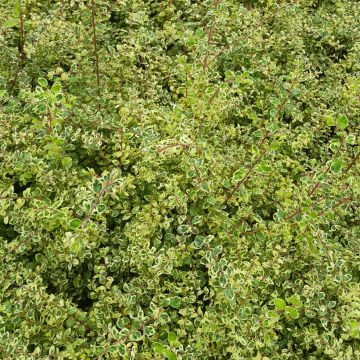

Comments